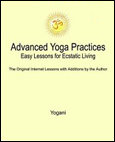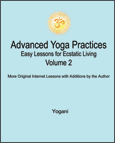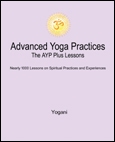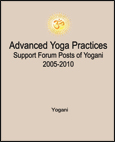|
Public Home | Plus Home | Main Lessons | Tantra Lessons | Public Forum | Plus Forum | Downloads | Books Topic Paths | Search | Training-Retreats | Testimonials | Survey | Interviews | MultiMedia | Contact | Donate |
|
Advanced Yoga Practices Note: For the Original Internet Lessons with additions, see the AYP Easy Lessons Books. For the Expanded and Interactive Internet Lessons, AYP Online Books, Audiobooks and more, see AYP Plus. Lesson 411 - Less is More (Audio)
AYP Plus Additions:
From: Yogani New Visitors: It is recommended you read from the beginning of the archive, as previous lessons are prerequisite to this one. The first lesson is, "Why This Discussion?"
So what's the truth? The truth is that the path and its destination are to large extent outside the province of the rational mind, and at the same time the source of all joy and freedom from suffering in this world. We each will find a way to pull ourselves up by our bootstraps to ascend to the ultimate human experience, which may be described as ecstatic bliss, empty awareness (nothingness), being one with everything, or all of these at the same time. The mind cannot comprehend it, so it often lands in a riddle. Nevertheless, the experiences are real enough, and our desire for truth spurs us on. It is the desire for more that we know in all avenues of life, and it is also the bridge between the life we are living now and the life we will come to know through ongoing spiritual openings. There is paradox here also. Desire and attachment have been called the bane of spiritual life, and at the same time the royal road to salvation: "Seek and you will find. Knock and the door will open." The whole journey is a doing without doing, a cultivation of stillness in action. This leads us straight into another paradox we have often discussed here: "Less is more." While "less is more" may seem mystical, there are tangible reasons for the apparent dichotomy. It has a practical side. For example, as we sit in spinal breathing pranayama and deep meditation, what are we doing? In both cases, we are refining our attention in the nervous system, going to less and less, cultivating purification and opening and a permanent expansion within, which eventually overflows into our everyday life. By systematically going to less, we are bringing more into our life more peace, more energy, more creativity, more love, and so on. This is the most basic demonstration of less becoming more, and we can see it manifesting in daily life. It has found expression in all the traditions of the world. Transcending outer life to the great reservoir within has long been known to be the fountain of all happiness, whether it is put into a religious context or not. It is also the principle behind all service. When we give, surrender something of ourselves, the flow coming back is multiplied. Less becomes more. In practices, we have often pointed to the practical application of "less is more" in discussing the principles and practices of "self-pacing." This applies in all levels of practice beginning, intermediate and advanced. As we develop our abilities in self-pacing, we can gain much more from our practices. The moderation of practices for balance yields the greatest results. If we are aggressive in practices and are purifying and opening too quickly, we will find less results from the more we are doing. In this case, more is less. Overloads can lead to long delays in daily practice, so a steady course that avoids such episodes is the surest path. Later on, when we have experienced an awakening of ecstatic conductivity (kundalini), we will find a self-sustaining momentum becoming active in our nervous system. While we continue to benefit greatly from daily practices, we may find that it will not take as much practice time or intensity to sustain the same degree of ongoing purification and opening as in the past. We have called this the "fly-wheel" effect, where our inner spiritual momentum has become largely self-sustaining. This does not mean we are done with practices, only that we may find ourselves to be more on the "razors edge" for sustaining good progress with comfort. This is when skill in self-pacing becomes more delicate, with the demonstration of "less being more" becoming very clear to us in daily living. When we slip in overdoing practices, or in our conduct, we find out right away. So moderation becomes the watchword in all things for the advanced yogi/yogini. At the same time, the flow from within us is increasing, and our influence increases proportionately, even as we seem to be doing less. We have called it "outpouring divine love." There is very little we have to do with it. We just act naturally and life happens. In time, we may feel we are doing nothing at all, even as everything is happening. It is less becoming more. Taken to completion, it is nothing becoming everything, stillness in action, the underlying principle behind all existence. We are That. And now we are back to the beginning of the discussion again. The path is the cultivation of a paradox in our ordinary life, with many practical steps along the way. Within it, we find the most practical thing in the world unending happiness. The guru is in you. Discuss this Lesson in the AYP Plus Support Forum Note: For detailed instructions on building and maintaining a balanced daily practice routine with self-pacing, see the Eight Limbs of Yoga Book, and AYP Plus. |
|
|

























